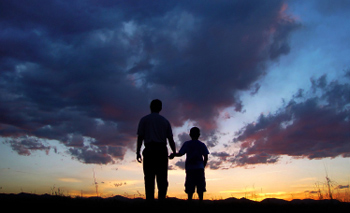When I was seven, I stayed for several days with my aunt and uncle. Something happened that long weekend that I have never forgotten. I’m convinced it helped to shape my early awareness of God and grace.
I was walking in the woods alongside my uncle, who went by the nickname “Lefty.” I happened to look up at him at the same moment he was looking down at me. Uncle Lefty met my gaze. I remember him smiling. That was it. Nothing else occurred, at least that I recall.
Why has this memory -- of all the experiences of childhood -- been so persistent? How is it that I can clearly recall my uncle’s patient face -- his smile -- after 37 years? All I can say is that I must have found something in that brief encounter deeply affirming. As a small child I did not have adequate words to describe it, but looking back with an adult’s vocabulary, what I remember feeling was this: “He lingers in my presence.” When you’re seven, very few people seem to linger in your presence. Most just hurry you along -- but not Uncle Lefty, not that day.
As a pastor, Easter -- with its sunrise services, robust hymns and a sanctuary chancel overflowing with brass musicians and lilies -- can leave me breathless. Similar to a family wedding, Easter requires months of planning, but when the day finally comes, seems to rush past me in a blur. That’s out of joint with the originating miracle of Easter, which occurred in the early morning stillness of a garden. No brass. No hosannas. No big production. The first Easter unfolded quietly, and, I think, slowly.
In the Easter story of John’s Gospel, Mary is alone in the garden. She comes upon a gardener and then notices that this gardener behaves oddly. Rather than going about his work, he lingers. Perhaps this was her first clue. “Mary,” he finally says. And, then, she recognizes him: “Rabbouni!”
This is one of the graces of Christ that often goes unrecognized. As my Uncle Lefty once did for me, Jesus always seemed to linger in the presence of others. His ministry of healing, for instance, was more than a miraculous touch. He was also attentive. Jesus did not hurry past the hemorrhaging woman or Bartimaeus or the children who asked to sit on his knee. He lingered before them and, I believe, that was in part what made each experience redemptive.
It’s Easter morning, and once again Jesus is patiently attentive. He is in no hurry. Content to play the gardener as long as necessary, the risen Christ lingers in Mary’s presence and ours.
Dietrich Bonhoeffer once summed up the Easter message with a simple declaration from the risen Christ: “See, I am with you.” Too often, we Protestants treat Easter as if it were the beginning of another story, when it is instead the continuation of the first story. This first story begins at creation as the Spirit of God hovers over the face of the deep. It culminates with incarnation -- Emmanuel, “God with us.” And it reaches its climax in resurrection. In this one story, the same God who broods over creation and comes impossibly near in Christ also refuses to hurry past us. Even death, it seems, cannot break the spell of divine love.
This is one side of the mystery of Easter that is often overlooked -- but once recognized, not easily forgotten. So perhaps alongside the traditional Easter proclamation, “He is risen,” we could also say, “He lingers.” God in Christ lingers in our presence. If we take this to heart, it is so deeply affirming that we might even be moved to respond: “He lingers, indeed.”









